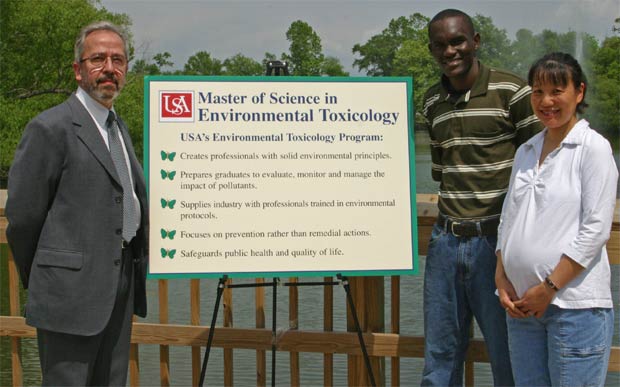The University of South Alabama is working to protect public health and the environment by launching the state’s only master of science degree program in environmental toxicology.
The degree program will have a tremendous impact on Mobile and the state because it fosters innovations that will change how the area deals with environmental issues in addition to providing industry with a pool of professionals who specialize in prevention.
According to Dr. Patsy Covey, senior vice president for academic affairs at USA, the new program is part of the University’s ongoing effort to understand and provide solutions to community environmental concerns.
“The University of South Alabama is very pleased to implement the environmental toxicology program because it’s so important to the future health and vitality of our state,” Covey said. “Our graduates are going to have the scientific expertise to help the state support economic growth while protecting the natural environment.”
Set to begin fall semester, the program will prepare graduates employed in industrial and other settings to better assess, monitor and manage the environmental impact of their work. It will also give them a better understanding of the biological effects of toxic exposure, and make them more informed on current legislation and protocols in the field of toxicology.
The new interdisciplinary graduate program involves departments in the colleges of Arts and Sciences, Engineering, Allied Health Professions and Medicine. It’s open to those with baccalaureate degrees in biology, biomedical sciences, chemistry, and chemical and civil engineering, and other areas with the appropriate prerequisites.
USA’s environmental toxicology program is unique in the state because it is tailored to address toxicology issues within a number of scientific disciplines. This specialization makes graduates more proficient in their fields and more attractive to the workforce, particularly industry.
Fostering strong collaboration between the University and community, the new program will give students an opportunity to work closely with faculty researchers, federal agencies and local companies, including those in USA’s new Technology and Research Park. The USA Cancer Research Institute will also provide research opportunities for students and faculty.
Graduates of the program will qualify for jobs in pharmaceutical and chemical companies as well as state, local and governmental agencies in areas such as industrial hygiene and environmental engineering.
“The University’s new environmental toxicology program was designed to fill a niche that has not been addressed in the state of Alabama,” said program director Dr. Julio Turrens, also a professor of biomedical sciences at USA.
“Our goal is to train graduates from various disciplines in different areas of toxicology, producing professionals able to apply solid environmental principles in their areas of expertise.”
 |
ENVIRONMENTAL TOXICOLOGY--Dr. Julio Turrens (left), director of the environmental toxicology degree program at USA, meets students who will enter the new master’s program when it begins in the fall. Brian Kelly of Nairobi, Kenya, and Yasuko Dodd of Kobe, Japan, are currently graduate students in chemical engineering at USA.
|
USA’s environmental toxicology program has received community support from both local environmental agencies and industry, according to Turrens.
“Everyone agrees that the focus should be on prevention,” he said. “Instead of spending billions of dollars in remedial actions, the goal is to minimize environmental impact.”
According to Turrens, the number of jobs for professionals with training in environmental toxicology is expected to grow substantially over the next several years. In fact, the Bureau of Labor Statistics has listed environmental engineers among the “New and Emerging Occupations.”
The work of professionals in this category may include ensuring compliance with environmental regulations and company policy, disposing of hazardous materials, and monitoring job safety and pollution emissions. Their jobs may also include work on environmental impact statements and assessments.
In the year 2000, there were approximately 52,000 environmental engineers nationwide, a number the Bureau projects could climb as high as 70,000 by 2010, representing a 35 percent increase.
“That is why this field has so much relevance today,” Turrens said. “Industry is interested in having professionals who are aware of environmental regulations and who know techniques that can prevent problems from ever happening.”

